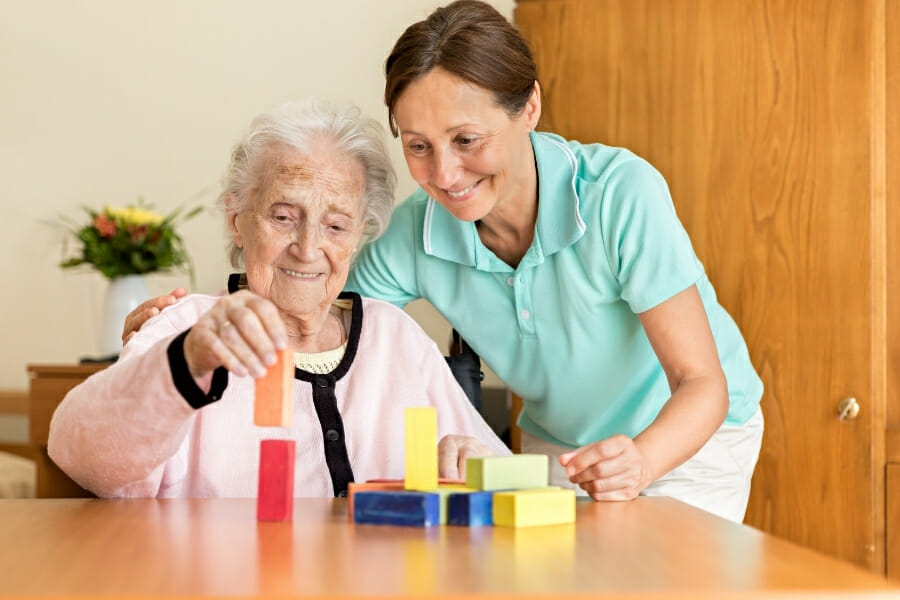Occupational therapy can help people of all ages participate in the things they want and need to do through the therapeutic use of everyday activities.
Occupational therapy is a skilled health profession dedicated to the improvement and maximization of function and performance so that people can live healthier, more productive, and more satisfying lives.
A licensed occupational therapist can help people strengthen their upper body, improve their balance, improve home safety, teach individuals how to use recommended adaptive equipment and educate family and caregivers on the best ways to care for a loved one.
If a nurse notes that a patient is having difficulty completing activities of daily living, such as bathing, dressing, or eating, they may ask for a referral for an occupational therapist.
Nurses are a vital part of a full care team and must work in conjunction with occupational therapists to help a person reach individual goals and maintain their maximum level of independence.
Often, occupational therapists recommend activities or modifications to help a range of people achieve personal goals: they can help individuals with disabilities participate fully in academic or social settings, help those recovering from injury regain a specific skill set, and provide support for older adults experiencing physical or cognitive decline.
For example, if a stroke survivor experienced loss of some function on one side of their body, the occupational therapist would assess the home for any safety concerns and create a customized plan, including recommended home modifications and adaptive equipment such as safety bars, a shower bench, or wheelchair ramp.
The OT would then train the individual on how to use any new equipment to help them maintain a sense of normalcy as they adjust to their new surroundings, and would also teach the individual’s family members how to use new equipment, how to lead daily exercises or other ways to best support their loved one.
The benefits of occupational therapy are numerous. It can improve an individual’s physical and mental health, physical benefits like range of motion, and increase their independence, and enhance their overall quality of life.
Occupational therapy can also help to prevent future injuries or disabilities by teaching individuals how to perform daily tasks safely and effectively.
With the help of an occupational therapist, individuals can overcome challenges and achieve their goals, no matter how big or small.
Let’s discuss some of the top benefits of occupational therapy.
Benefits of Occupational Therapy

Occupational therapy can be particularly beneficial for older adults wanting to maintain a sense of independence.
Occupational therapy is a medical specialty that helps people of all ages to participate in daily living activities. OT promotes health, well-being, and participation in daily life.
Here are some of the key benefits of occupational therapy:
Improves Quality of Life
Occupational therapy helps patients improve their quality of life by providing them with the tools and skills they need to participate in daily activities.
Occupational therapy helps patients to regain their independence and improve their overall health and well-being.
Helps in Rehabilitation
Occupational therapy is an essential part of rehabilitation for patients who are recovering from an injury, illness, or surgery.
OT helps patients to regain their strength and mobility, and it also helps to reduce pain and discomfort.
Boosts Motor Skills
Occupational therapy helps to improve motor skills, including fine motor skills, balance, and strength. The therapy helps patients to develop the skills they need to perform daily activities such as dressing, grooming, and eating.
Overall, occupational therapy is an effective way to improve the quality of life for patients who are recovering from an injury, illness, or surgery.
The therapy helps patients to regain their independence and improve their overall health and well-being.
Additional OT Benefits
An OT can improve the lives of seniors by:
- Improving physical functioning in frail older adults, or seniors living with osteoarthritis and macular degeneration.
- Recommending home modifications and adaptive equipment to reduce functional decline and improve safety.
- Encouraging exercises involving functional activities, as well as progressive resistance strength training to improve mobility. Strengthening, balance retraining, and a walking plan are important in reducing the risk of falls and injuries for those over 80 years old.
- Scheduling on-road instruction to improve driving knowledge and skills and enhance on-road safety.
- Using bioptics to improve simulated and on-road driving skills, as well as outdoor mobility skills for older adults with visual impairments.
- Supporting training of life and social skills to help older adults with Alzheimer’s disease, dementia, or other forms of cognitive decline to improve daily interactions.
- Creating a health plan, including physical activity regimen, outdoor activities, cognitive training and social stimulation to reduce the risk of depression and improve community involvement.
Who Can Benefit from Occupational Therapy?
IN THIS ARTICLE

Occupational Therapy for Children
Occupational therapy can be very beneficial for children of all ages. Children often receive occupational therapy services to address issues with participation and performance in activities of daily living (ADLs) typical for their age group.
Successful completion of self-care routines helps them to build confidence and autonomy.
Occupational therapy can also help children in school by improving their ability to focus, follow directions, and develop fine motor skills.
By working with an occupational therapist, children can learn skills that will help them to succeed in school and in life.
Occupational therapy can help children to develop the skills they need to be independent and to perform daily tasks, such as dressing, feeding, and grooming themselves.
Occupational Therapy for Adults
Occupational therapy is not just for children. Adults can also benefit from occupational therapy. Occupational therapists work with adults to help them improve their ability to perform daily tasks, such as cooking, cleaning, and dressing themselves. They can also help adults to develop the skills they need to be successful in the workplace.
Occupational therapy can help adults to improve their independence and quality of life. It can also help them to manage chronic conditions, such as arthritis or diabetes.
By working with an occupational therapist, adults can learn strategies for coping with their condition and for managing their symptoms.
Older adults are not the only ones who can benefit from occupational therapy. An OT can greatly improve the lives of people living with Parkinson’s, Alzheimer’s, or other chronic diseases, as well as individuals who have survived a sudden health crisis.
Here are a few of the ways an OT can help!
- Multiple sclerosis: Inpatient rehabilitation can reduce the severity of symptoms of the disease and improve the ability to complete activities of daily living. Personalized, computerized cognitive training programs at home can also improve attention, memory, information processing, and executive functioning.
- Parkinson’s Disease: Repetitive physical exercises can improve diachronic motor and sensory-perceptual performance skills.
- Post-Stroke Recovery: Specialized therapy plans can help individuals achieve personal recovery goals. An OT will provide instructions that focus on task-related parameters as opposed to specific movements.
Remember that occupational therapy is especially beneficial for recovery following a hospital discharge from a stroke, surgery, fall, or other health crisis.
Occupational therapy can help people return to their previous level of functioning and increase independence.
Whether people need assistance with post-hospital recovery, home safety, or socialization, occupational therapy can help in meaningful ways because occupational therapists develop a personalized plan to help each individual achieve personal goals.
Need an In-Home Nurse?
If a loved one would benefit from constant care and treatment in the comfort of their home, discover how a private duty nurse from NurseRegistry can help.
We offer streamlined access to professional nurses with a wide variety of specialty skills, along with assistance with everyday tasks.
Click below to learn more today.
Frequently Asked Occupational Therapy Questions
What are the benefits of occupational therapy for children?
Occupational therapy can benefit children with a wide range of conditions, including developmental delays, sensory processing disorders, and autism spectrum disorders.
Through play-based activities, occupational therapists can help children develop fine motor skills, hand-eye coordination, and sensory integration. They can also work with children to improve their self-care skills, such as dressing and feeding themselves.
What are the advantages and disadvantages of occupational therapy?
The advantages of occupational therapy include improved physical and mental health, increased independence, and better quality of life.
The disadvantages may include the cost of therapy, the time commitment required, and the need for ongoing treatment.
What is the importance of occupational therapy?
Occupational therapy is important because it helps people of all ages and abilities to participate in activities that are meaningful to them.
By addressing physical, cognitive, and emotional barriers to participation, occupational therapists can help people achieve their goals and improve their overall well-being.
How does occupational therapy benefit mental health?
Occupational therapy can benefit mental health by helping individuals develop coping strategies, improve their self-esteem, and enhance their social skills.
Through activities such as art therapy, music therapy, and mindfulness exercises, occupational therapists can help individuals manage symptoms of depression, anxiety, and other mental health conditions.
What are the benefits of occupational therapy for adults?
Occupational therapy can benefit adults by helping them recover from injuries or illnesses, improve their mobility and strength, and manage chronic conditions such as arthritis and diabetes.
Occupational therapists can also help adults maintain their independence and quality of life as they age.
How does occupational therapy help with cerebral palsy?
Occupational therapy can help individuals with cerebral palsy improve their motor skills, communication abilities, and independence.
Through activities such as stretching exercises, adaptive equipment, and assistive technology, occupational therapists can help individuals with cerebral palsy achieve their goals and participate in activities that are meaningful to them.
Sources
American Occupational Therapy Association. (2014). Occupational therapy in primary care. American Journal of Occupational Therapy, 68(Suppl. 3), S25–S33.
The American Occupational Therapy Association. (2016). What is occupational therapy.
The American Occupational Therapy Association. (2016). Evidenced based outcomes.
Centers for Medicare and Medicaid Services. (2015). Better care. Smarter spending. Healthier people: Paying providers for value, not volume [Press release].
Hay, J., LaBree, L., Luo, R., Clark, F., Carlson, M., Mandel, D., Azen, S. P. (2002). Cost effectiveness of preventive occupational therapy for independent-living older adults. Journal of the American Geriatric Society, 50(8), 1381–1388. See more at: http://www.aota.org/About-Occupational-Therapy/Professionals/EBP/Cost-Effective-Health-Care-Reform.aspx#sthash.8JnQX5Zr.dpuf
Jutkowitz, E., Gitlin, L. N., Pizzi, L. T., Lee, E., & Dennis, M. P. (2012). Cost effectiveness of a home-based intervention that helps functionally vulnerable older adults age in place at home. Journal of Aging Research, 680265. See more at: http://www.aota.org/About-Occupational-Therapy/Professionals/EBP/Cost-Effective-Health-Care-Reform.aspx#sthash.8JnQX5Zr.dpuf
Occupational Therapists. (2004) Bureau of Labor Statistics, US Department of Labor ,Occupational Outlook Handbook.






